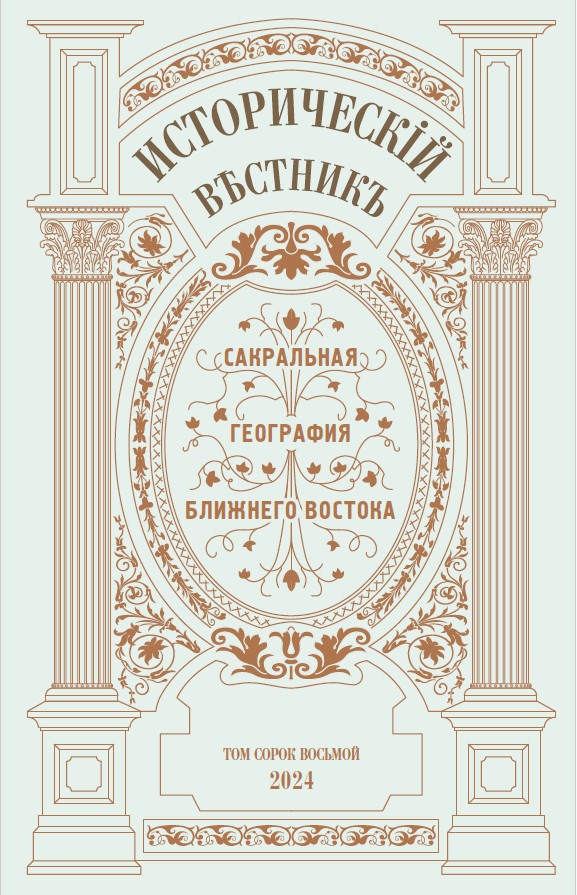
Панченко К.А. Сакральная география в истории авраамических религий востока
DOI: 10.35549/HR.2024.2024.48.017Панченко К.А. Сакральная география в истории авраамических религий востока // Исторический вестник. 2024. Т. XLVIII. С. 20–37.
Аннотация
Статья посвящена перспективным направлениям исследований проблематики сакральной географии. Это понятие включает в себя широкий спектр сюжетов – объекты поклонения, «места силы», календарный цикл праздников, паломничество и сопутствующие ритуалы. Ее предлагается рассматривать не как статичную картину святых мест и религиозных обрядов той или иной этноконфессиональной группы, но изучать в динамике, как процесс постоянного изменения, усложнения или упрощения системы культовых объектов, разрастания или упадка вдохновленного ими литературного творчества.
Статья обращается к общим сюжетам эволюции сакральной географии в религиозных традициях иудаизма эпохи Второго храма, различных течений восточного христианства, ислама. Рассматриваются, в частности, факторы, влиявшие на разрастание или деградацию системы мест поклонения той или иной религии, а также такие сюжеты, как феномен святых городов, традиции паломничества, способствующие этнической или над-этнической консолидации, а в некоторых случаях и составлявшие основу самой экономики религиозных структур. Наибольший интерес представляют примеры соперничества за обладание св. местами или почитаемыми реликвиями между религиозными исповеданиями или внутри их, а также за уничтожение в ходе межрелигиозного противоборства вражеских сакральных объектов.
Ключевые слова: сакральная география, паломничество, культ святых мест, культ мучеников, иудаизм эпохи Второго храма, восточное христианство, ислам, межрелигиозное противоборство.
Панченко Константин Александрович – доктор исторических наук, профессор кафедры Истории стран Ближнего и Среднего Востока Института стран Азии и Африки МГУ имени М.В. Ломоносова.
***
PanchenkoC.A. Sacred Geography in the History of Abrahamic Religions of the East // Historical Reporter. 2024. Vol. 48. P. 20–37.
Abstract
This article focuses on promising avenues of research in the field of sacred geography. This concept encompasses a broad spectrum of topics, including objects of worship, «places of power», the calendar cycle of festivals, pilgrimage, and associated rituals. It is suggested to view sacred geography not merely as a fixed collection of sacred sites and religious practices tied to particular ethno-religious communities, but as a dynamic process characterized by ongoing changes, complexities, or simplifications in the system of revered objects, as well as the expansion or decline of literary creations inspired by them.
The article discusses the general themes of sacred geography's evolution within the religious traditions of Second Temple Judaism, various branches of Eastern Christianity, and Islam. In particular, it examines factors influencing the expansion or degradation of worship sites in specific religions, as well as topics such as the phenomenon of holy cities and pilgrimage traditions that foster ethnic or supra-ethnic consolidation, and in some cases, underpin the economies of religious structures. Of particular interest are instances of competition for control over sacred sites or revered relics among or within religious groups, as well as the destruction of sacred objects in inter-religious conflicts.
Key Words: Sacred Geography, Pilgrimage, Cult Of Holy Sites; Cult Of Martyrs, Second Temple Judaism, Eastern Christianity, Islam, Interreligious Conflicts.
Constantin A. Panchenko — D.Sc. (History), Professor of the Institute of Asian and African Studies of the Moscow State University, Department of Middle Eastern and Central Asian Studies.
***
References
- Brett M. Population and conversion to Islam in Egypt in Medieval Period / Egypt and Syria in the Fatimid, Ayyubid and Mamluk Eras // OLA. 140. Leuven, 2005. P.1–32.
- Chentsova V.G. «Iverskaya» Icon of Theotocos (Essays of a History of Relations between the Greek Church and Russia in the mid. 17th cent. according to Documents of RGADA) [Ikona Iverskoy Bogomateri (ocherki istorii vzaimootnosheniy Grecheskoy Tserkvi s Rossiey v seredine XVII v. po dokumentam RGADA)]. Мoscow, 2010.
- Griffith S. The Arabic Account of ‘Abd al-Masih an-Nagrani al-Ghassani / Griffith S. Arabic Christianity in the Monasteries of Ninth-Century Palestine. Great Yarmouth, 1992. Ch. X. P.331–374.
- Karalevskij C. Antioche // Dictionnaire d’histoire et de géographie ecclésiastiques. T. III. (1924). Col. 563–703.
- Panchenko C.A. The Monastery of Saidnaya [Saydnayskiy monastyr’] / Pravoslavnaya Encyclopedia. Т. LXI. Мoscow, 2021. P.151–156.
- Panchenko C.A. A Cult of Neo-Martyrs among the Melkites of the Late Middle Ages [Kul’t novomuchenikov u melkitov v pozdnee Srednevekov’ye] // Vestnik PSTGU. Ser. III: Filologiya. 2022. T. 73. P.71–83.
- Shiffman L. From 1text to Tradition. A History of Second Temple and Ktav [Ot teksta k traditsii. Istoriya iudaizma v epohu vtorogo hrama i v period Mishny i Talmuda]. Transl. in Russian. Jerusalem; Moscow, 2002.
- Tkachenko A.A. The Rabbinic Judaism [Iudaizm Ravvinisticheskiy] / Pravoslavnaya Encyclopedia. Т. 28. P.405–407.
- Schuerer E. The History of the Jewish People in the Age of Jesus Christ (175B.C.— A.D. 135). Edinburg, 1973.
- Segal J. Edessa, «the Blessed City». Oxford, 1970.
- Stoyanov Y. Archaeology versus Written Sources: The Case of the Persian Conquest of Jerusalem in 614 // Acta Musei Varnaensis. 2007. T. 8. № 1. P.351–358.
- Swanson M. The Coptic Papacy in Islamic Egypt (641–1517). Cairo; N.Y., 2010.
- Talmon-Heller D. Graves, Relics and Sanctuaries: the Evolution of Syrian Sacred Topography (11th–13th cent.) // ARAM, 18–19 (2006–2007). P.601–620.

